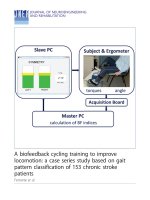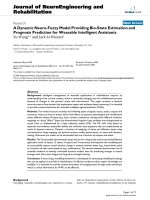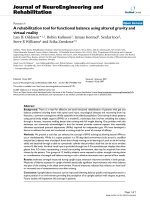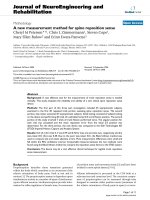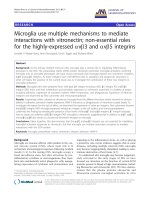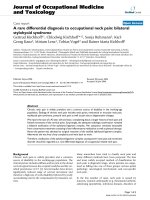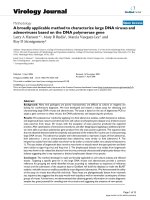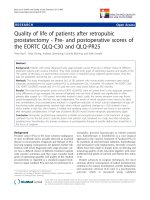Báo cáo hóa học: " A broadly applicable method to characterize large DNA viruses and adenoviruses based on the DNA polymerase gene" doc
Bạn đang xem bản rút gọn của tài liệu. Xem và tải ngay bản đầy đủ của tài liệu tại đây (452.2 KB, 10 trang )
BioMed Central
Page 1 of 10
(page number not for citation purposes)
Virology Journal
Open Access
Methodology
A broadly applicable method to characterize large DNA viruses and
adenoviruses based on the DNA polymerase gene
Larry A Hanson*
1
, Mary R Rudis
1
, Marcia Vasquez-Lee
1
and
Roy D Montgomery
2
Address:
1
Department of Basic Sciences, College of Veterinary Medicine, Mississippi State University, P.O. Box 6100, Mississippi State, Mississippi
39762, USA and
2
Department of Pathobiology and Population Medicine, College of Veterinary Medicine, Mississippi State University, P.O. Box
6100, Mississippi State, Mississippi 39762, USA
Email: Larry A Hanson* - ; Mary R Rudis - ; Marcia Vasquez-Lee - ;
Roy D Montgomery -
* Corresponding author
Abstract
Background: Many viral pathogens are poorly characterized, are difficult to culture or reagents are
lacking for confirmatory diagnoses. We have developed and tested a robust assay for detecting and
characterizing large DNA viruses and adenoviruses. The assay is based on the use of degenerate PCR to
target a gene common to these viruses, the DNA polymerase, and sequencing the products.
Results: We evaluated our method by applying it to fowl adenovirus isolates, catfish herpesvirus isolates,
and largemouth bass ranavirus (iridovirus) from cell culture and lymphocystis disease virus (iridovirus) and
avian poxvirus from tissue. All viruses with the exception of avian poxvirus produced the expected
product. After optimization of extraction procedures, and after designing and applying an additional primer
we were able to produce polymerase gene product from the avian poxvirus genome. The sequence data
that we obtained demonstrated the simplicity and potential of the method for routine use in characterizing
large DNA viruses. The adenovirus samples were demonstrated to represent 2 types of fowl adenovirus,
fowl adenovirus 1 and an uncharacterized avian adenovirus most similar to fowl adenovirus 9. The
herpesvirus isolate from blue catfish was shown to be similar to channel catfish virus (Ictalurid herpesvirus
1). The case isolate of largemouth bass ranavirus was shown to exactly match the type specimen and both
were similar to tiger frog virus and frog virus 3. The lymphocystis disease virus isolate from largemouth
bass was shown to be related but distinct from the two previously characterized lymphocystis disease virus
isolates suggesting that it may represent a distinct lymphocystis disease virus species.
Conclusion: The method developed is rapid and broadly applicable to cell culture isolates and infected
tissues. Targeting a specific gene for in the large DNA viruses and adenoviruses provide a common
reference for grouping the newly identified viruses according to relatedness to sequences of reference
viruses and the submission of the sequence data to GenBank will build the database to make the BLAST
analysis a valuable resource readily accessible by most diagnostic laboratories. We demonstrated the utility
of this assay on viruses that infect fish and birds. These hosts are phylogenetically distant from mammals
yet, sequence data suggests that the assay would work equally as well on mammalian counterparts of these
groups of viruses. Furthermore, we demonstrated that obtaining genetic information on routine diagnostic
samples has great potential for revealing new virus strains and suggesting the presence of new species.
Published: 11 April 2006
Virology Journal2006, 3:28 doi:10.1186/1743-422X-3-28
Received: 16 November 2005
Accepted: 11 April 2006
This article is available from: />© 2006Hanson et al; licensee BioMed Central Ltd.
This is an Open Access article distributed under the terms of the Creative Commons Attribution License ( />),
which permits unrestricted use, distribution, and reproduction in any medium, provided the original work is properly cited.
Virology Journal 2006, 3:28 />Page 2 of 10
(page number not for citation purposes)
Background
Many viral pathogens of animals are poorly characterized.
To date, if a suspected new virus was identified and the
virus could be cultured, morphology, physical characteris-
tics, growth characteristics and antigenic nature were
determined. This method of characterization is very time
consuming and is limited to culturable viruses (in estab-
lished cell lines or readily available primary cells). Usu-
ally, because of the time and expense, this
characterization is limited to viruses that are associated
with an important disease. However, a large portion of
viruses are either unculturable, difficult to culture or are
not associated with a disease of importance to justify in-
depth characterization or development of reliable sero-
logical reagents. Even with culturable viruses, confirma-
tive diagnosis is often not done because of a lack of
diagnostic antibodies or PCR assays. Therefore the devel-
opment of broad spectrum diagnostic methods that obvi-
ate culture are needed as well as methods to bypass the
cumbersome traditional methods of characterizing cultur-
able viruses. We addressed this need by using identified
sequence conservation between an important group of
viral pathogens, the large DNA viruses and adenoviruses.
Alignment of the amino acid sequences the DNA
polymerase of representatives of Adenoviridae, Poxviri-
dae, Herpesviridae, Iridoviridae, and Baculoviridae reveal
two regions that display a high level of conservation [1].
The upstream region showed two different contiguous
sequences of conservation with potential for degenerate
probe development with the adenoviruses grouping in
one, and the herpesviruses, poxviruses, iridoviruses and
baculoviruses grouping in the second. One downstream
conserved region was shared by all of the virus groups. We
designed degenerate primer sets using different upper
primers corresponding to the two upstream amino acid
sequences and a common lower degenerate primer corre-
sponding to the downstream amino acid sequence. We
then validated the assay by using these primers to amplify
the fragment of the DNA polymerase gene from case iso-
lates or infected tissues of Ictalurid herpesvirus 1(channel
catfish virus-CCV), two iridoviruses-lymphocystis disease
virus (LDV) and largemouth bass ranavirus (LBV), avian
adenoviruses and avian poxviruses. We were able to read-
ily obtain the expected products from all of these viruses
except the avian poxviruses. In order to obtain the
sequence for the avian poxvirus, DNA extraction methods
were optimized and new primers were developed. The
poxvirus sequence was finally obtained and the difficulty
was likely due to secondary structure of the PCR product
and/or competition by aberrant products.
Results
Sequence alignment
The deduced amino acid sequences of DNA polymerases
encoded by representative members of several subgroups
of DNA viruses of animals (herpesviridae, poxviridae,
adenoviridae and baculoviridae) had been aligned [1] and
two areas of conservation were identified. We analyzed
these regions in additional viruses including Ostreid her-
pesvirus 1, African swine fever, iridoviridae, an ascovirus,
and whitespot disease virus of shrimp. We were looking
for two highly conserved regions of consecutive amino
acids (aa), spaced 70 – 400 aa apart. This would allow the
design of degenerate PCR primers that would cover a large
number of viruses and yield a useful, easily amplified
product (large enough for sequence comparisons yet
small enough for efficient PCR). There was considerable
variation in the deduced amino acid sequences between
families. Several small regions of conservation were iden-
tified. Only one region with conservation of at least 5 con-
secutive amino acids was found among nearly all
sequences evaluated. This was the YGDTD sequence pre-
viously described [1]. The only differences among viruses
analyzed were a serine instead of the glycine at the second
amino acid of the Ascovirus and methionine, alanine
instead of tyrosine, glycine as the first two amino acids in
Ostreid herpesvirus 1. Approximately 400 to 700 bp
upstream of this region was a portion that was relatively
conserved in all of the virus groups except Adenoviridae
but a region approximately 1200 bp upstream within ade-
noviridae was conserved (Figure 1). Therefore we
designed one degenerate downstream primer to be used
for all large DNA viruses of vertebrates (Cons lower
primer-5'cccgaattcagatcTCNGTRTCNCCRTA3' N = A/C/
G/T, R = A/G) and two degenerate upstream primers, one
representing Adenovirus (Adeno primer-
5'gggaattctaGAYATHTGYGGNATGTAYGC3' Y = T/C, H =
A/C/T) and the other based on herpesvirus sequences but
representing the other large DNA viruses of vertebrates
(HV primer-5'cggaattctaGAYTTYGCNWSNYTNTAYCC3' S
= C/G, W = A/T) (Figure 1). We added additional
sequence to the 5' ends to improve amplification proper-
ties with lower primer having 14 nucleotides (nt) of addi-
tional sequence and the upper primers having 10 nt of
additional sequences (indicated above by lowercase let-
ters). The additional sequences also provided EcoRI and
BglII restriction enzyme recognition sites to the lower
primer and EcoRI and XbaI recognition sites to the upper
primers that could be used for cloning purposes. When
the amino acid sequences used to design the Adeno
primer and the cons lower primer were used together in
BLAST analysis against the GenBank non-redundant data-
base, only adenovirus DNA polymerase genes were found
with substantial identity. When the amino acid sequences
used to design the HV primer and cons lower primer were
used together in BLAST analysis against the GenBank non-
redundant database, a wide variety of DNA polymerase
genes were found to contain identical or nearly identical
sequences. These included the DNA polymerase genes of
the virus groups listed in figure 1 as well as a large number
Virology Journal 2006, 3:28 />Page 3 of 10
(page number not for citation purposes)
Amino acid alignment of conserved regions of the DNA polymerase of selected viruses and representative primers designed for this studyFigure 1
Amino acid alignment of conserved regions of the DNA polymerase of selected viruses and representative
primers designed for this study. Upper primers are displayed 5'-3' and the lower primer is displayed 3'-5'. Underlined
lower case nt represent 5' regions with no homology to coding region. The ~ 1200 bp and 400–700 bp following the adeno and
HV primers indicate the respective distance to the region with homology to the lower primer. Represented sequences are:
Aviadenovirus – fowl adenovirus A [GenBank:NP_043878
], Mastadenovirus-human adenovirus C [GenBank:NP_040516], Ata-
denovirus-duck adenovirus 1 [GenBank:NP_044702
], Siadenovirus-frog adenovirus [GenBank:NP_062435], α Herpesvirus-
human herpesvirus 1 [GenBank:NP_044632
], β Herpesvirus1-human herpesvirus 5 [GenBank:P08546], β Herpesvirus2-human
herpesvirus 6 [GenBank:NP 042931
], γ Herpesvirus-human herpesvirus 4 [GenBank:NP_039908], Ictalurid HV-Ictalurid her-
pesvirus 1 [GenBank:NP_041148
], Ranid HV-ranid herpesvirus 1 [GenBank:AAD12269], Ostreid HV-Ostreid herpesvirus 1
[GenBank:AAS00986
], African SFV-African swine fever virus [GenBank:NP_042783], Avipoxvirus-fowlpox virus [Gen-
Bank:NP_039057
], Orthopoxvirus-Vaccinia [GenBank:NP_063712], Entomopoxvirus-Melanoplus sanguinipes entomopoxvirus
[GenBank:NP_048107
], Lymphocystivirus-lymphocystis disease virus 1 [GenBank:NP_078724], Ranavirus-frog virus 3 [Gen-
Bank:YP_031639
], Iridovirus-Invertebrate iridescent virus 6 [GenBank:NP_149500], Chloriridovirus-Invertebrate iridescent
virus 3 [GenBank:CAC84133
], Ascovirus-Heliotis virescens ascovirus [GenBank:AJ312696]. Granulovirus1-Cryptophlebia leu-
cotreta granulovirus [GenBank:NP_891948
], Granulovirus2-Xestia c-nigrum granulovirus [GenBank:AAF05246],
Nucleopolyhedrovirus1-Lymantria dispar nucleopolyhedrovirus [GenBank:NP_047720
], Nucleopolyhedrovirus2-Orgyia pseu-
dotsugata multicapsid nuclear polyhedrosis virus [GenBank:Q83948
], Whispovirus-shrimp white spot syndrome virus [Gen-
Bank:AAK77696
].
Aviadenovirus D I C G M Y A Y G D T D
Mastadenovirus . . . . . . . . . . . .
Atadenovirus . . . . . . . . . . . .
Siadenovirus . . . . . . . . . . . .
Adeno Primer 5’gggaattctaGACATATGCGGAATGTACGC3’ ~1200bp
T C T C T
T G
T
Herpesvirus D F A S L Y P . . . . .
Herpesvirus1 . . . . . . . . . . . .
Herpesvirus2 . . Q . . . . . . . . .
Herpesvirus . . . . . . . . . . . .
Ictalurid HV . . T . M . . . . . . .
Ranid HV . . . . . . . . . . . .
Ostreid HV . . N . Q . . MA . . .
African SFV . . . . . . . . . . . .
Avipoxvirus . YN . . . . . . . . .
Orthopoxvirus . YN . . . . . . . . .
Entomopoxvirus . YT . . . . . . . . .
Lymphocystivirus . . S . . . . . . . . .
Ranavirus . .S . . . . . . . . .
Iridovirus . . S . . . . . . . . .
Chloriridovirus . . S . . . . . . . . .
Ascovirus . VN . M . . . S . . .
Granulovirus1 . . S . . . . . . . . .
Granulovirus2 . . Q . . . T . . . . .
Nucleopolyhedrovirus1 . . NA . . . . . . . .
Nucleopolyhedrovirus2 . . N . . . L . . . . .
Whispovirus . MT . . . . . . . . .
HV Primer 5’cggaattctaGACTTCGCAACACTATACCC3’ ~400-700bp
T T CTGCT C T
G G G
T T T
Y G D T D
Cons Lower primer (anti-sense) 3’ATACCACTATGACTctagacttaagccc5’
G C G C
G G
T T
Virology Journal 2006, 3:28 />Page 4 of 10
(page number not for citation purposes)
of members of the Phycodnaviridae, Archea, plants, fungi,
ciliates, plasmodia, nematodes, echinoderms, insects, and
vertebrates. The vertebrate host tissues and cells repre-
sented the strongest potential source of unwanted PCR
products but the vertebrate DNA polymerase genes con-
tain introns making the DNA polymerase products from
the host genomic DNA much larger than from viral
genomic DNA. The predicted PCR product from the
mouse genome would be 2622 nt [GenBank:NC_000073
]
and for 3556 nt for Danio rerio [GenBank:NC_007114
].
Application of primer sets to representative viruses
We tested the designed primer sets on avian and fish case
isolates representing the most common DNA viruses of
vertebrates that contain DNA polymerase genes: herpes-
viridae, iridoviridae, poxviridae and adenoviridae.
The DNA polymerase PCR was performed on three aden-
ovirus isolates from infected chicken primary fibrobasts
using the Adeno and Cons lower primers. All three gave
strong single bands at the expected 1200 bp size (Figure
2A). Direct sequencing done on the excised products
using upper and lower primers respectively demonstrated
that the products of our chicken embryo lethal orphan
virus (CELO, fowl adenovirus 1) strain of Fowl adenovi-
rus A, and case 162 were similar and case 1422 demon-
strated some divergence from the other two. The products
were cloned and sequenced using vector primers and
Agarose electrophoretic profiles of amplification products from DNA polymerase targeted-degenerate PCR from avian adeno-virus samples (A], catfish herpesvirus samples (B), fish iridovirus samples (C) and Avian Poxvirus samples (D)Figure 2
Agarose electrophoretic profiles of amplification products from DNA polymerase targeted-degenerate PCR
from avian adenovirus samples (A], catfish herpesvirus samples (B), fish iridovirus samples (C) and Avian Pox-
virus samples (D). The > indicates bands that were evaluated by sequencing. A-chicken adenovirus isolates CELO-lane 1,
case 162-lane 2, case 1422b-lane 3 using adenovirus upper and consensus lower primers. The products of interest were 1200
bp. B-lanes designated CCV and BCV represented the type specimen (Auburn clone A) and the blue catfish isolates respec-
tively produced 465 bp bands using HV and cons lower primers. C-Largemouth bass ranavirus type specimen-LBV, and lym-
phocystis disease virus case (infected fin tissue) LDV produced 695 bp and 662 bp bands, respectively, using HV and cons lower
primers. D Avian Poxvirus from Quail (QPV) and turkey (TPV) produce multiple bands using the HV and Cons lower primers
on DNA extracts from infected chicken chorioallantoic membranes.
Virology Journal 2006, 3:28 />Page 5 of 10
(page number not for citation purposes)
internal sequencing primers to resolve the entire frag-
ments. The sequences of the first two adenovirus samples
were identical to the published sequences of the repre-
sented region of CELO [GenBank:U46933
]. The case 1422
isolate sequence [GenBank:DQ159938
] was most similar
to the respective region of fowl adenovirus 9 strain of
Fowl adenovirus D [GenBank:AF083975
] of adenovirus
DNA polymerases that had been sequenced. The 1145 nt
region between the primers showed 68.5% identity at the
nucleotide level and a corresponding 66.4% identity at
the amino acid level.
As a test for utility of DNA polymerase PCR on herpesvirus
samples, DNA was amplified from virus isolates from two
cases of diseased from blue catfish (Ictalurus furcatus)
using the HV primer with the Cons lower primer. These
isolates were designated as "blue catfish virus" (BCV)
because they were shown to be herpesviruses by electron
microscopy and produced similar cytopathic effect on
CCO cells as CCV but would replicate in the Chinook
salmon embryo cell line (CHSE 214) where as CCV would
not. The DNA for these samples and the type isolate of
CCV were isolated from infected CCO cells. All three pro-
duced a distinct 465 bp band after DNA polymerase PCR
(Figure 2B lanes CCV and BCV represent type virus and
blue catfish isolate respectively). Cloning and sequencing
this fragment from the two blue catfish isolates [Gen-
Bank:DQ159941
] demonstrated 100% nt identity
between each other and 97.7% nt identity to CCV (10 nt
difference in 439 nt) with 100% amino acid identity. This
suggests that the blue catfish isolate is a strain of CCV and
our data provides strong evidence for a broader host range
for CCV.
To test the utility of the primer set for Ranavirus genus of
the Iridoviridae, we used the HV-Cons lower primer set on
DNA from two isolates of largemouth bass ranavirus
(LBV). One was the type virus, the other was a case isolate
from a diseased largemouth bass in Mississippi. Both were
cultured on fathead minnow cells and both yielded 695
bp products (figure 2C-LBV). The PCR products of both
isolates were identical [GenBank:DQ159940
]. No previ-
ous LBV DNA polymerase sequence had been submitted
to GenBank. The highest BLAST scores were to the DNA
polymerase genes of tiger frog virus [Gen-
Bank:AAL77804.1
] and frog virus 3 [Gen-
Bank:AAT09720.1
]. Simple alignment of the 641 nt
between the primers demonstrated 76.6% (491 nt) and
76.3% (490 nt) identity to tiger frog virus and frog virus 3
respectively. The deduced 213 aa sequence demonstrated
80.28% (171 aa) identity to each.
To test the utility of this assay for Lymphocystis disease
virus (LDV) genus of Iridoviridae and the use of this assay
directly on tissues, DNA was extracted from pathogno-
monic lymphocystis disease lesion on the caudal fin of a
largemouth bass. The 662 bp product was amplified using
the HV primer with the Cons lower primer (figure 2C,
Lane LDV). Sequence analysis [GenBank:DQ159939
]
demonstrated that the highest similarity of the 608 nt
region between the primers was the corresponding region
from a LDV isolated from flounder in China [Gen-
Bank:AY380826.1
] with 75.16% (457 nt) identity. The
deduced 202 aa sequence demonstrated 77.7% (157 aa)
identity. In comparison the same region from LDV 1 from
flounder in North America [GenBank:L63545.1
] demon-
strated 70.68% nt identity and 69% deduced aa identity.
Our data suggests that the largemouth bass isolate of LDV
may be a different species from the two previously charac-
terized LDV isolates.
To test the utility of the assay on Poxviridae we obtained
avian poxvirus isolates from quail and turkey. DNA sam-
ples extracted from infected chicken chorioallantoic
membrane tissue were used to performed the degenerate
PCR assays. We generated many different bands in these
assays (Figure 2D, lanes QPV and TPV for quail and turkey
isolates respectively) so two bands closest to the expected
600 bp these were re-amplified, cloned and sequenced.
BLAST analysis demonstrated that both of the sequences
were derived from chicken genomic DNA. To reduce host
genomic DNA contamination we filtered the tissue
homogenate through 0.45 µm filters and DNAse treated
the samples before nucleic acid extraction. These treat-
ments greatly simplified the banding pattern (compare
Figure 2D with Figure 3A, lanes Qp and Tp were filtered
and Lanes Qd and Td were DNAse treated). Cloning and
sequencing of 3 bands all revealed fowl pox sequences but
none were the DNA polymerase gene. We theorized that
the problem may have been due to excessive mis-matches.
The Chordopoxvirinae upstream amino acid sequence was
DYNSLYP verses DFASLYP this would result in 3 nt mis-
matches at the 5' end of the upstream target. When we cal-
culated the degeneracy required to cover Chordopoxvirnae,
and Herpesviridae, we would have a degeneracy of 32768,
which was excessive. However, if we made 8 separate
degenerate primers and combined them we could elimi-
nate nucleotide combinations at the serine and leucine
encoding sites that do not encode the desired amino acid.
This resulted in a primer mixture with a degeneracy of
3456, lower than the HV primer. We tried the new primer
set. Cloning and sequencing of three bands close to the
expected 600 bp size revealed avipoxvirus sequences but
no DNA polymerase gene. We re-evaluated potential
primers for poxviruses. Alignment using Chordopoxvirinae
DNA polymerase aa sequences identified an alternative
upstream primer. The best contiguous sequence near the
previous upstream primer target was YCIHDAC. PCR
using the respective degenerate upstream primer 5'TAYT-
GYATHCAYGAYGCNTG'3 and the cons lower primer gen-
Virology Journal 2006, 3:28 />Page 6 of 10
(page number not for citation purposes)
erated the expected 882 bp band from both quail and
turkey isolates (figure 3B). This primer set generated the
expected band on nucleic acid extracts from the tissue, tis-
sue homogenate that had been filtered and virus pelleted
and pelleted virus that was treated with DNAse before
extraction but not from control tissue. Figure 3 clearly
demonstrates the advantage of concentrating the virus
and treating the sample with DNAse to eliminate non-spe-
cific bands [compare lanes T, Q and N (tissue extract) to
Tp, Qp and Np (pelleted virus extract) and Td Qd and Nd
(pelleted and nuclease treated before extraction)]. The
DNA polymerase gene fragment product from the turkey
isolate was confirmed by sequencing. It exactly matched
that of fowlpox virus [GenBank:NC_002188
].
Aberrant products that were sequenced during this
research generally provided only small regions of similar-
ity to known DNA sequences, often having some similar-
Agarose electrophoretic profiles of amplification products from DNA polymerase targeted-degenerate PCR on quail and tur-key isolates of avian poxvirus using the consensus lower primer with HV upper primer (A), and the poxvirus specific primer (B)Figure 3
Agarose electrophoretic profiles of amplification products from DNA polymerase targeted-degenerate PCR
on quail and turkey isolates of avian poxvirus using the consensus lower primer with HV upper primer (A), and
the poxvirus specific primer (B). Lanes are designated Q, T and N for quail virus, turkey virus and no virus infected
chicken chorioallantoic membrane, respectively, + indicates the positive control (CCV DNA) and – indicates a negative water
control, 1 Kb = 1 Kb ladder (Invitrogen), lower case letters indicate extraction protocols with no designation being a total
DNA extraction from the tissue, p indicating pelleted sample (the virus was filtered through a 0.45 µm filter and pelleted at
20,000 × g before DNA extraction) and d indicating DNase treament (the pelleted sample was resuspended and DNase
treated before DNA extraction). The > indicates product that was sequenced.
Virology Journal 2006, 3:28 />Page 7 of 10
(page number not for citation purposes)
ity to microsatellite sequences or to putative retrovirus
provirus sequences of various genomes. The most com-
mon of the aberrant products generated from the poxvirus
research was a portion of ORF FPV115 an Ankyrin repeat
gene family protein [2].
Discussion
The use of degenerate primers to DNA polymerase gene to
amplify a DNA fragment and identify the presence of
DNA viruses have been used by many researchers for spe-
cific research projects or to characterize a virus associated
with a specific disease. Also, the amino acid sequences of
DNA polymerase of many large DNA viruses have been
compared to evaluate virus relationships and compared to
the DNA polymerases of other organisms to hypothesize
the relationship and origin of this family of mole-
cules[1,3,4]. The regions targeted with our degenerate
primers were identified by the original alignment of Ito
and Braitwaite [1] and overlap regions designated as
regions 2 and 4 by Villarreal et al [4]. VanDevanter et al [5]
used degenerate primers to the DNA polymerase gene of
mammalian and avian herpesviruses to identify unknown
herpesviruses and were successful in identifying gene
sequences of herpesviruses from several species of mam-
mals. They were however, unsuccessful in amplifying the
DNA fragment from CCV and did not evaluate the utility
of there primers on other families of DNA viruses. Our
primers targeted similar regions as two of their primers.
Our HV primer targeted was similar to their DFA primer
targeting the DFASLYP sequence. The 3' (gene specific)
portion of our sequence being
5'GAYTTYGCNWSN
YTNTAYCC3' compared to
5'GAYTTYGCNAGY
YTNTAYCC3'. Their IYG downstream
primer targeted IYGDTDSV with the corresponding
degenerate primer being
5'CACAGAG
TCCGTRTCNCCRTADAT3'. Our Cons lower
primer targeted YGDTD with the gene specific portion of
the degenerate primer being TCN
GTRTCNCCRTA3'.
Ehlers et al [6] utilized similar primers as VanDevanter et
al [5] but they included deoxyinosines at sites with a
degeneracy of 3 or more. The differences in the primers
allows all codons for serine to be represented in the HV
primer and the narrower target of our cons lower primer
accounts for different amino acids flanking the YGDTD
sequence in non-herpesvirus targets. Our objective in this
study was to develop a broad spectrum method that could
be used to characterize most large DNA viruses including
those in which the virus type is poorly defined, those that
have not been cultured and those that come from a host
that is phylogenetically distant from the hosts of well
characterized members of the DNA viruses. This goal
necessitated the use primers with a high degree of degen-
eracy. Yet, most of the samples readily yielded the desired
products even when there were up to two nt mismatches
(with CCV). Our success is likely due to the high copy
number of viral genomes present on our DNA extracts.
The specific product yield was substantially increased
when the filtration step, virus concentration and DNase
treatment were added to the tissue/cell extraction proce-
dure. We believe that these steps substantially reduced the
complexity of the target and improved the efficiency of the
degenerate primer PCR.
We chose to use generic primer sets with more degeneracy
rather than family specific primer sets because they would
be more readily used in a diagnostic environment. The use
of limited generic primer sets allows for the application of
the assay before the disease agent is as extensively charac-
terized. The use of generic primers has the added advan-
tage of covering most known variants, this minimizes the
effect of unique species-specific sequences within a "con-
served" region that often occur in virus families. We dem-
onstrated the utility of our assay on defined virus isolates
and virus samples that had not been characterized of four
families of DNA viruses. Furthermore, we demonstrated
that the methodology was directly applicable to infected
tissues. The PCR products generated from this assay are
sufficiently long for detailed sequence comparison and for
the development of specific PCR primers for diagnostic
and research applications.
Our difficulty in generating a fragment from the poxvirus
sample was unexpected because the degenerate primers
were matched to that sequence. The alternate primer set
worked very well and because the secondary structure may
cause similar problem with poxviruses the use of the pox
specific primer set may be warranted when a poxvirus is
suspected. In the process of optimizing the procedure for
the poxviruses, we found that the use of DNAse treatment
of the tissue/cell homogenate before DNA extraction
greatly improved the specificity of the assay. Even with the
poxvirus, the primer sets that did not amplify the DNA
polymerase did amplify poxvirus sequences and sequence
analysis of non-targeted sequences may be of use in char-
acterizing a newly discovered virus. The use of nuclease
treatment in conjunction with sequence independent sin-
gle primer amplification has been very successful for iden-
tifying unknown viruses in serum samples [7]. The
advantage of using degenerate PCR is that the product
obtained is a fragment of a specific gene, which simplifies
comparisons to known orthologs for phylogenetic place-
ment of the virus.
The assay that we developed is being quickly adapted in
fish virology community to evaluate suspected cases of
virus infected tissues or to characterized culturable
viruses. The primers were successfully used to amplify the
DNA polymerase gene products from 3 cyprinid herpesvi-
ruses, [8,9](personal communication Janet Warg, Diag-
nostic Virology Laboratory, National Veterinary Services
Virology Journal 2006, 3:28 />Page 8 of 10
(page number not for citation purposes)
Laboratories, Ames, Iowa). This assay has been used to
characterize 7 herpesviruses from sturgeon [10].
Conclusion
In this report, we use a defined region of a gene common
to all large DNA viruses to develop a general diagnostic
method that is broadly applicable to a wide spectrum of
viruses. We demonstrated the utility of this system on cell
culture isolates and on infected tissues of four major
groups of DNA viruses; the Poxviridae, Herpesviridae,
Adenoviridae and Iridoviridae. Although the assay was
applied to a small sample of the viruses (1–3 examples per
group), they represented diverse virus families and
included up to 2 amino acid mismatches in the upstream
target region. Success by other laboratories and amino
acid sequence analysis of DNA polymerases of other
members of these groups supports the broad applicability
of this assay to the large DNA viruses and adenoviruses of
vertebrates. The Phycodnaviridae found in algae, Baculo-
viridae and Ascoviridae found in arthropods and the her-
pesviruses of mollusks should also be amenable to this
procedure with modified primers. This assay will not work
on RNA viruses and DNA virus types that do not have a
DNA dependant DNA polymerase gene such as Hepadna-
viridae, Circoviridae, Parvoviridae, Papillomaviridae and
Polyomaviridae. We demonstrated the benefit of using
the defined region for matching case isolates to species
that have been previously sequenced and demonstrated a
useful scenario for identifying species of which the DNA
polymerase gene have not been previously sequenced. As
this target fragment of more species of DNA viruses are
sequenced, BLAST and GenBank will prove to be a utilitar-
ian software and database for virus diagnostic work that is
readily available to all diagnostic and research laborato-
ries. The advantages of the selected target for diagnostic
use are: it is sufficiently small that the product can be effi-
ciently generated, yet, there are regions that are highly
conserved allowing general placement of unknown
viruses into families and there are regions of sufficient var-
iation to allow the development of specific PCR primers.
The use of DNAse pretreatment in the extraction protocol
simplified the substrate and to allow effective amplifica-
tion even with highly degenerate primers.
Our optimized protocol is: 1. Disrupt the cells/tissue to
release the virions. 2. Pellet the cellular debris by centrifu-
gation at 1000 × g for 5 min. 3. Filter the supernatant
through a 0.45 µm filter. 4. Concentrate the virus from the
filtrate by centrifugation at 21,000 × g for 30 min. 5.
Resuspend the pellet in a small volume of water and
DNase treat the suspension to reduce cellular DNA. 5.
Extract the DNA. 6. Run degenerate PCR. 7. clone pre-
dominant bands of the appropriate sizes (450–800 bp for
the HV primer and 1200 bp for the Adenovirus primer). 8.
Sequence the products and use BLASTx to compare the
translated sequence to deduced amino acid sequences in
GenBank. Variations that are helpful are (1) to use larger
amounts of cells or tissues in samples that are suspected
of having low numbers of virions and (2) to run a negative
control of non-infected tissue when multiple weak bands
are produced to distinguish cellular products from virus
product candidates.
Methods
Virus sources
All diagnostic case samples were submitted to the Missis-
sippi State University, College of Veterinary Medicine
Diagnostic Laboratory. Virus isolates were obtained from
infected diagnostic samples by homogenizing the tissues
in serum free medium (SFM) or tryptose phosphate broth
(TPB) at the rate of approximately 1 part tissue to 5 parts
TPB (vol:vol), passed through a 0.20 µm filter, and diluted
1:10 (vol:vol) in SFM or TPB containing penicillin (100
units/ml) and streptomycin (100 µg/ml).
Avian samples were inoculated onto 24-hour-old monol-
ayers of chicken embryo kidney (CEK) cells or onto the
chorioallantoic membrane (CAM) of embryonated eggs.
For CAM culture, eleven-day-old embryonated eggs from
a commercial specific-pathogen free (SPF) source (Hy-
Vac, Inc., Gowrie, IO) were inoculated via the CAM route
using 0.2 ml of the antibiotic-treated sample/egg. The eggs
were sealed, incubated at 37°C, and candled daily. Those
eggs containing live embryos 6 days later, were opened
and the CAMs in the area of inoculation were examined.
CAMs containing plaques or similarly-suspicious lesions
were harvested and pieces placed into McDowell's fixative
for histological examination. The rest of the affected
membranes were held frozen (-60°C). Histological evalu-
ation identified CAM samples as avian poxvirus-infected
when epithelial hyperplasia and eosinophilic intracyto-
plasmic inclusions were demonstrated [11]. Inoculated
CEK cells were observed daily. At 2, 4, and 6 days postin-
oculation (PI), aliquots of cells and supernatant were har-
vested and frozen at -70°C. These aliquots were pooled
and served as subsequent inocula for two additional 6-day
passages. Harvests from any passage showing evidence of
"round-cell" cytopathology were tested against adenovi-
rus-specific antiserum (SPAFAS, Inc., Norwich, Conn.) in
an agar-gel precipitin (AGP) test. Avian poxvirus isolate
4905 was from a quail in 1984 and isolate M6959 from a
wild turkey near Jackson Mississippi in 1989. The avian
adenovirus isolates, were chicken embryo lethal orphan
(CELO) virus that was used as the positive control for the
AGP test, case isolates 162 and 1422b were from diseased
chickens in commercial broiler operations in Mississippi
in 2002.
Channel catfish virus was either the type strain (Auburn
clone A-American Type Culture Collection) or from diag-
Virology Journal 2006, 3:28 />Page 9 of 10
(page number not for citation purposes)
nostic cases S98-675 and S98-697 from diseased blue cat-
fish Ictalurus furcatus from a commercial catfish
production pond near Inverness, Mississippi in 1998.
Virus was propagated by infecting monolayers of channel
catfish ovary cell line at approximately 0.1 plaque forming
units per cell and freezing the cells and medium when the
entire cell sheet was involved in cytopathic effect (CPE).
Largemouth bass virus (LMBV) case isolate was from a dis-
eased largemouth bass (Micropterus salmoides) found in a
private use pond near Brandon, Mississippi (case C01-
170) in 2001. The type specimen was from the first
described case of LMBV from the Santee-Cooper reservoir,
South Carolina [12] and was provided by Dr. V. Greg
Chinchar (University of Mississippi Medical Center, Jack-
son MS). Both were cultured on the Fathead Minnow
(FHM) cell line. The lymphocystis disease virus sample
was extracted from fin lesions from largemouth bass with
lymphocystis disease (case C02-033, found in a commer-
cial catfish production pond near West Point, Mississippi
in 2002).
Sample preparation
Virus from infected cell cultures in 25 cm
2
flasks were
released from the cells by serial freeze thaw cycles, the
debris was centrifuged out at 1000 × g for 5 min then virus
was concentrated out of the supernatant by centrifugation
at 21,000 × g for 30 min in a microfuge. The pellet was
suspended in 80 µl of water. When tissues were evaluated,
the DNA was either extracted directly from a 50 mg tissue
sample or virus was concentrated from the sample. This
was done by homogenizing approximately 200 mg of the
tissue sample in 2.25 ml of serum free cell culture
medium, centrifuging the sample at 1000 × g for 5 min
and concentrating the virus out of the supernatant as
described above. The filtration variation to the protocol
involved filtering the supernatant of the 1000 × g centrif-
ugation step with a 0.45 µm syringe filter then proceeding
to the virus concentration step. The DNase variation on
the protocol involved adding 20 µl of 10 × buffer and 100
µl of RQ1 DNAse (Promega) to the 80 µl of concentrated
virus and incubating it at 37°C for 2 hours. This was fol-
lowed by the addition of 20 µl of stop buffer (20 mM
EGTA, pH 8.0) and a 10 min incubation at 65°C to inac-
tivate the DNAse. DNA was isolated using Puregene
genomic DNA isolation system (Gentra, Minneapolis,
MN). The sample was suspended in 600 µl Puregene cell
lysis solution containing 60 µg proteinase K, incubated
overnight at 50°C then the DNA was isolated according to
the manufacture's suggested procedure. DNA was quanti-
tated using UV spectrophotometry (GeneSpec I, Hitachi
Software Engineering Company LTD, Japan).
Degenerate PCR and cloning
PCR consisted of approximately 100 ng of template DNA,
20 pmole of each primer, 4 µl 10 mM dNTP, 5 µl 10 ×
buffer, 2.5 U Taq polymerase mix (Fisher Scientific) in 50
µl reactions. PCR used the appropriate forward primer
and the consensus reverse primer (Figure 1). The reaction
conditions were: 93°C, 1 min for one cycle followed by
93°C, 30 sec; 45°C, 2 min; 72°C 3 min for 35 cycles fol-
lowed by a single cycle at 72°C for 4 min. Product was
evaluated by electrophoresis on 1.5% agarose gels fol-
lowed by staining with GelStar nucleic acid gel stain (Bio-
Whittaker Molecular Applications, Rockland, ME) and UV
transillumination (ChemiImager 5500, Alpha Innotech
Corporation, San Leandro, CA). Bands of interest were
excised from the gel and the DNA was recovered using
GenElute Agarose Spin Columns (Supelco, Bellefonte,
PA). The product was cloned into plasmid pT7blue using
the Perfectly Blunt Cloning Kit (Novagen) or the plasmid
pCR4-TOPO using the TOPO TA cloning kit (Invitrogen).
Selected candidate clones were evaluated for a DNA insert
of the appropriate size using colony PCR (as described in
the Perfectly Blunt or TOPO TA cloning kit). Then plasmid
was purified for sequencing from 1 ml cultures using the
QIAQUIK plasmid purification kit (Qiagen).
Sequencing
PCR products from all virus samples except the adenovi-
rus isolates were cloned and then sequenced. Sequencing
was performed on both strands of at least three clones
from each product using vector specific forward and
reverse sequencing primers in with the ABI PRISM™ Big
Dye Terminator Cycle Sequencing Ready Reaction Kit
(Applied Biosystems, Foster City, CA) and by the use of
the ABI PRISM™ 310 Genetic Analyzer (Applied Biosys-
tems). A modification of this was the use of direct
sequencing of the Adenovirus PCR product using 500 ng
of template excised from an agarose gel and 3.2 pmole of
upper or lower primer, respectively. Additional sequenc-
ing was done on cloned PCR products from the adenovi-
rus samples using vector specific forward and reverse
sequencing primers, a lower strand primer-
ACGATTTSAGTGCCTTCGTAGATG and a upper strand
primer-CATCTACGAAGGCACTSAAATCGT. Data were
assembled using MacDNASIS and sequences were edited
by manual comparison of overlapping electropherograms
(Version 3.7, Hitachi Software Engineering America, Ltd.,
South San Francisco, CA). The DNA sequence data were
analyzed and amino acid sequences deduced using MacD-
NASIS. Related amino acid sequences were identified
using BLASTx [13]. ClustalX [14] was used to align the
deduced amino acid sequences of the DNA polymerase
fragment.
Competing interests
The author(s) declare that they have no competing inter-
ests.
Publish with BioMed Central and every
scientist can read your work free of charge
"BioMed Central will be the most significant development for
disseminating the results of biomedical research in our lifetime."
Sir Paul Nurse, Cancer Research UK
Your research papers will be:
available free of charge to the entire biomedical community
peer reviewed and published immediately upon acceptance
cited in PubMed and archived on PubMed Central
yours — you keep the copyright
Submit your manuscript here:
/>BioMedcentral
Virology Journal 2006, 3:28 />Page 10 of 10
(page number not for citation purposes)
Authors' contributions
LAH obtained fish case isolates, performed the DNA
sequence comparisons, designed the primers and was the
contributing author. MRR performed all fish virus cell cul-
ture, DNA extraction, PCR protocol development, and
most of the PCR, cloning and sequencing. MV-L cloned
and sequenced the adenovirus samples and the type spec-
imen of LMBV. RDM obtained avian diagnostic isolates
and produced the virus for these assays. All authors con-
tributed to the writing of this manuscript.
Acknowledgements
The authors thank Ms Lana Jones for assistance in chicken fibrobast and
chorioallantoic membrane cultures and Dr. Lester Khoo for providing the
BCV isolates. We also thank the reviewers for helpful suggestions. This
work was a continuation of research initiated by Dr. Huang-Ge Zhang. This
research was supported by the Mississippi Agricultural and Forestry Exper-
iment Station (MAFES). This is MAFES publication J-10862.
References
1. Ito J, Braithwaite DK: Compilation and alignment of DNA
polymerase sequences. Nucleic Acids Res 1991, 19:4045-4057.
2. Afonso CL, Tulman ER, Lu Z, Zsak L, Kutish GF, Rock DL: The
genome of fowlpox virus. J Virol 2000, 74:3815-3831.
3. Braithwaite DK, Ito J: Compilation, alignment, and phyloge-
netic relationships of DNA polymerases. Nucleic Acids Res 1993,
21:787-802.
4. Villarreal LP, DeFilippis VR: A hypothesis for DNA viruses as the
origin of eukaryotic replication proteins. J Virol 2000,
74:7079-7084.
5. VanDevanter DR, Warrener P, Bennett L, Schultz ER, Coulter S, Gar-
ber RL, Rose TM: Detection and analysis of diverse herpesviral
species by consensus primer PCR. J Clin Microbiol 1996,
34:1666-1671.
6. Ehlers B, Borchers K, Grund C, Frolich K, Ludwig H, Buhk HJ: Detec-
tion of new DNA polymerase genes of known and potentially
novel herpesviruses by PCR with degenerate and deoxyinos-
ine-substituted primers. Virus Genes 1999, 18:211-220.
7. Allander T, Emerson SU, Engle RE, Purcell RH, Bukh J: A virus dis-
covery method incorporating DNase treatment and its
application to the identification of two bovine parvovirus
species. Proc Natl Acad Sci U S A 2001, 98:11609-11614.
8. Waltzek TB, Kelley GO, Stone DM, Way K, Hanson L, Fukuda H,
Hirono I, Aoki T, Davison AJ, Hedrick RP: Koi herpesvirus repre-
sents a third cyprinid herpesvirus (CyHV-3) in the family
Herpesviridae. J Gen Virol 2005, 86:1659-1667.
9. Goodwin AE, Khoo L, Lapatra SE, Bonar C, Key DW, Garner M, Lee
MV, Hanson L: Goldfish Hematopoietic Necrosis Herpesvirus
(Cyprinid herpesvirus 2) in the USA: Molecular Confirma-
tion of Isolates from Diseased Fish. Journal of Aquatic Animal
Health 2006, 18:11–18.
10. Kelley GO, Waltzek TB, McDowell TS, Yun SC, Lapatra SE, Hedrick
RP: Genetic relationships among herpes-like viruses isolated
from sturgeon. Journal of Aquatic Animal Health 2005, 17:297-303.
11. Tripathy DN, Reed WM: Pox, Chapter 9. In Diseases of Poultry 11th
edition. Edited by: Saif YM, Barnes HJ, Glisson JR, Fadly AM, McDou-
gald LR and Swayne DE. Ames, Iowa State University Press;
2003:253-299.
12. Plumb J, Grizzle J, Young H, Noyes A, Lamprecht S: An iridovirus
isolated from wild largemouth bass. Journal of Aquatic Animal
Health 1996, 8:265-270.
13. Altschul SF, Gish W, Miller W, Myers EW, Lipman DJ: Basic local
alignment search tool. J Mol Biol 1990, 215:403-410.
14. Thompson JD, Higgins DG, Gibson TJ: CLUSTAL W: improving
the sensitivity of progressive multiple sequence alignment
through sequence weighting, position-specific gap penalties
and weight matrix choice. Nucleic Acids Res 1994, 22:4673-4680.

